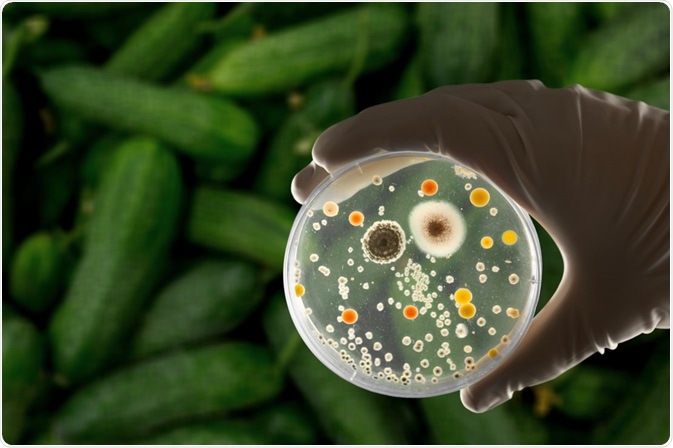With food being transported across increasing distances and customers expecting extended shelf-lives for many consumables, there is a greater need for food preservatives to prevent spoilage. If contaminated food products reach the consumer, the consequences can be far-reaching, and potentially serious. It is for this reason that the food industry has to comply with strict quality regulations to safeguard the public.
 Image Credit: Billion Photos / Shutterstock.com
Image Credit: Billion Photos / Shutterstock.com
A variety of additives are used to reduce food deterioration as a result of contaminating enzymes and microorganisms. Typically, a range of chemical preservatives is also used in food production, such as sodium benzoate, benzoic acid, nitrites, sulfites, sodium sorbate, and potassium sorbate.
Additives and preservatives are designed to protect consumers. However, concerns about the potential toxicity of chemical preservatives grow and there is a trend towards customers looking for foods without chemical additives. This has intensified the search for naturally occurring preservatives.
In particular, it is desirable to identify non-chemical antibacterial and antifungal agents, since food-borne bacteria and fungi pose a potential health threat1. Furthermore, some pathogenic and spoilage microorganisms have become resistant to the chemical preservatives traditionally used so novel compounds are needed to ensure the safety and freshness of our food.
Biopreservatives
Several proteins have already been found to possess natural antimicrobial properties. These antimicrobial peptides, such as lactoferricin and nisin, have mainly been isolated from milk and egg where they act to protect new life from pathogens, including Staphylococcus aureus, Escherichia coli and yeast2,3.
Recently, lactic acid bacteria such as Lactobacillus plantarum have been found to produce a range of metabolites that have antifungal as well as antimicrobial properties4. The compounds with antifungal activity include cyclic dipeptides, phenyllactic acid, proteinaceous compounds, and 3-hydroxylated fatty acids. The metabolites with antimicrobial activity include bacteriocin, cyclic dipeptides, organic acids, fatty acids, and carboxylic acids.
Lactic acid bacteria are not considered to be harmful to mammals and occur naturally in many foodstuffs. They have thus been identified as promising candidates for isolating compounds that could provide natural alternatives to chemical preservatives for protecting foodstuffs from contamination by bacteria and fungi. However, despite such potential, the use of lactic acid bacteria in the food industry to protect against microorganisms has been limited.
Antimicrobial activity of lactobacilli
Lactobacillus strains have exhibited antimicrobial activities against a range of different food-borne pathogenic bacteria and food spoilage fungi. Increasing interest in the application of lactic acid bacteria in the production of natural food preservatives has prompted a flurry of research to identify antimicrobial compounds with potential commercial utility.
Lactobacillus plantarum isolated from kimchi, a traditional Korean fermented vegetable product, demonstrated antimicrobial activities against both Gram-positive and Gram-negative bacteria as well as antifungal activities5. These activities were not lost on exposure to gastric acid and bile and did not present a health risk due to antibiotic resistance.
Organic acids, lactic acid, and acetic acid were identified as the active antimicrobial and antifungal components. In addition, an unidentified antimicrobial compound was found to be present.
To characterize the unknown antimicrobial compound, it was purified using solid-phase extraction and recycling preparative high-performance liquid chromatography.
The structure was determined by 1H and 13C nuclear magnetic resonance (NMR) using a Bruker AVANCE 500 NMR spectrometer6. Two-dimensional 1H–13C heteronuclear multiple quantum coherence (HMQC), 1H–13C heteronuclear multiple bond correlation (HMBC), 1H–13C heteronuclear multiple bond correlation (HMBC), and 1H–1H correlation spectroscopy (COSY) experiments were also conducted.
In addition, the study investigated the mechanism of the inhibitory activity against food-borne pathogenic bacterium and spoilage mold.
The purified active compound was identified as 3-hydroxy-5-dodecenoic acid and found to be stable at physiological pH6. Its antimicrobial effects were shown to be achieved through severe damage to the surface of vegetative cells, and they were enhanced when it was used in combination with lactic and acetic acids6.
Such cell damage led to the aggregation of damaged cells, thereby achieving bactericidal and fungicidal effects against B. cereus and A. fumigatus. The antimicrobial efficacy of 3-hydroxy-5-dodecenoic acid against A. fumigatus and B. cereus was achieved at concentrations much lower than those required with the commonly used chemical preservative, sodium benzoate. It could, therefore, offer cost savings in addition to health benefits.
This latest study provides promising data on the antimicrobial activity of Lactobacillus plantarum, and structure elucidation of a newly discovered active metabolite may inform the development of biopreservatives enabling natural protection against fungal food spoilage and contamination with foodborne pathogens.
References
- Schnürer J & Magnusson J. Trends in Food Science & Technology 2005;16(1–3):70–78.
- Krivorotova T, et al. Biotechnol Prog. 2017;33(1):245-251.
- Chen R, et al. J Biomed Mater Res B Appl Biomater. 2017;105(8):2612-2617.
- Crowley S, et al. Trends in Food Science & Technology 2013;33(2), 93–109.
- Choi EA & Chang HC. LWT-Food Science and Technology 2015;62(1):210–217.
- Mun SY, et al. LWT - Food Science and Technology 2019;14:108403. https://doi.org/10.1016/j.lwt.2019.108403
About Bruker BioSpin - NMR, EPR and Imaging

Bruker BioSpin offers the world's most comprehensive range of NMR and EPR spectroscopy and preclinical research tools. Bruker BioSpin develops, manufactures and supplies technology to research establishments, commercial enterprises and multi-national corporations across countless industries and fields of expertise.